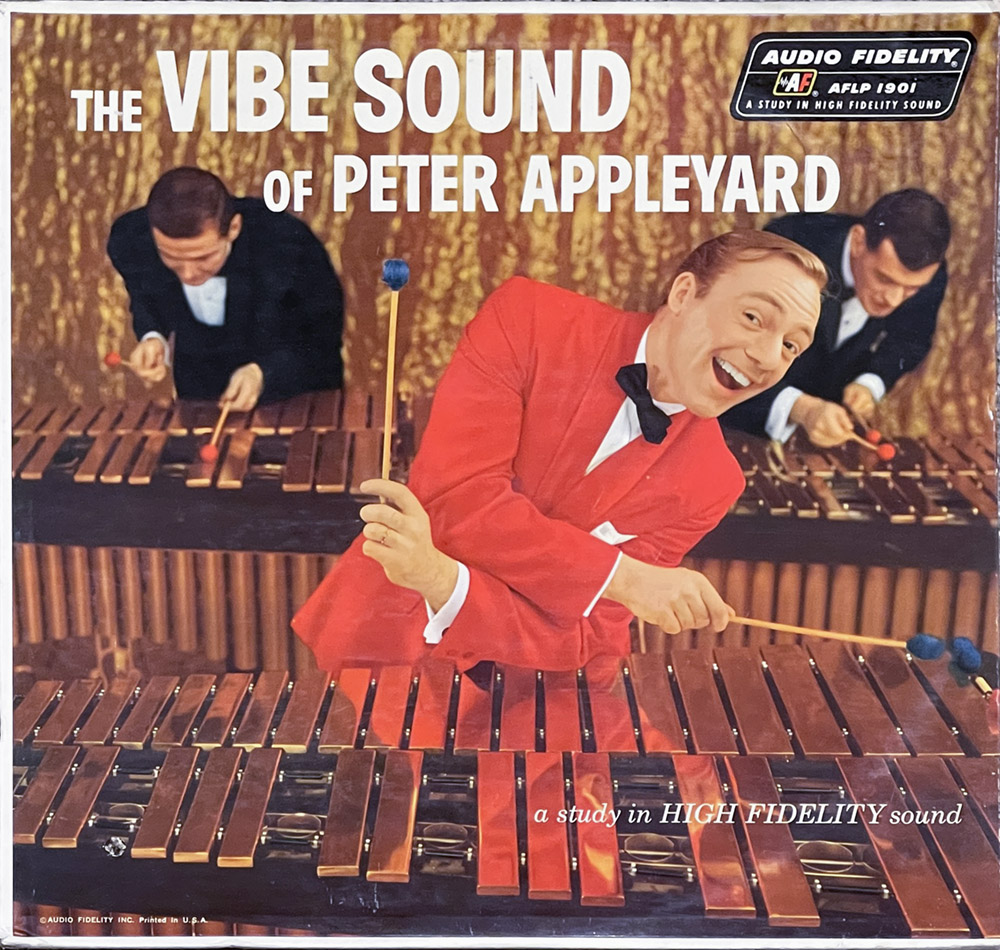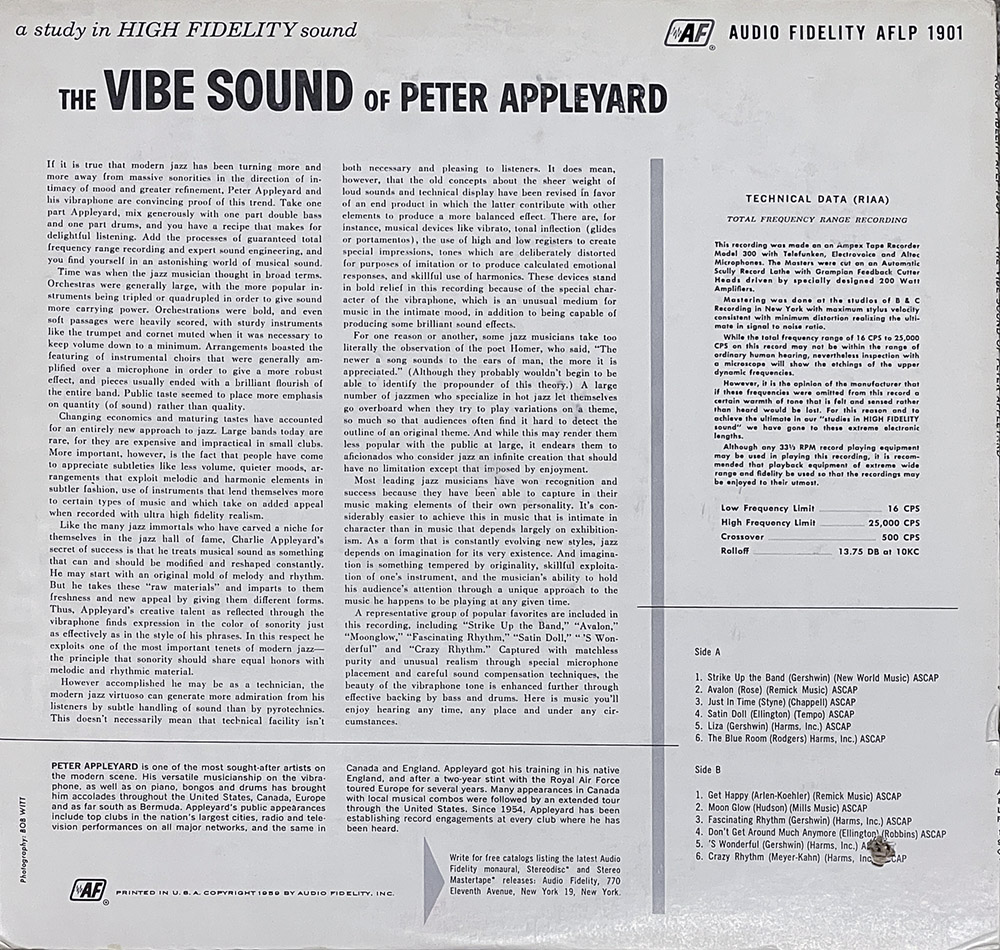Hello, audio adventurers! It’s Finnley the Dolphin here, ready to plunge into the sonic depths of a true jazz treasure: “The Vibe Sound of Peter Appleyard.” Released in 1959, this album is a hallmark of jazz and easy listening, showcasing the magical resonance of the vibraphone like never before. As we explore this iconic record, we’ll discover how it captured the essence of an era and pushed the boundaries of sound technology, leaving a lasting impact on the audio world. Join me as we spin this classic vinyl and relive the vibrant rhythms that made Peter Appleyard a legend in the jazz community.
Peter Appleyard’s musical odyssey began in the seaside town of Cleethorpes, Lincolnshire, where he was born on August 26, 1928. As a young man, his path was shaped by the economic hardships of World War II, which forced him to abandon his formal education and eventually led him to apprentice as a nautical instrument maker. However, the captivating sounds of American Big Bands, resonating even across the Atlantic, ignited a deep passion within him, compelling Peter to pursue a career in jazz—a genre that was rapidly capturing the hearts of many during that era.
In the early 1940s, Peter’s musical journey commenced earnestly. He played the drums in various British dance bands and, while serving in the Royal Air Force, performed in RAF bands, honing his skills and broadening his musical exposure. By 1949, seeking new adventures and greater opportunities, Appleyard moved to Bermuda, where he served as the resident bandleader at prestigious hotels. His enchantment with the vibraphone began during his frequent visits to Canada, a fascination that would significantly shape his musical career.
Eventually drawn to North America permanently, Peter settled in Toronto. Despite initial challenges, including working as an elevator doorman to make ends meet, his persistence and passion for music soon led him to the vibrant stages of Toronto’s jazz scene. He played at renowned venues such as the Park Plaza Hotel and quickly became a popular figure in nightclubs and hotels across the city. During the 1950s and 1960s, Peter formed his own jazz ensemble, which not only performed extensively throughout North America but also appeared on American television.
Appleyard’s involvement with Audio Fidelity Records in the production of the album “Percussive Jazz” highlighted his innovative spirit. The album aimed to compete with the likes of Enoch Light’s stereo recordings that blended percussion and pop music. Despite initial challenges, the album underscored the potential of stereo technology in enhancing the depth and texture of jazz music.
Released in 1959 under Audio Fidelity Records, “The Vibe Sound of Peter Appleyard” is celebrated not only for its musical artistry but also for its groundbreaking achievements in recording quality. This album brought new life to jazz standards and popular hits like “Strike Up the Band,” “Avalon,” “Moonglow,” and “Satin Doll,” thanks to its advanced high fidelity recording techniques.

The production utilized cutting-edge technology to fully capture the vibraphone’s rich spectrum of tones. Specialized microphone placements and sound compensation techniques were employed to ensure that each note was rendered with unparalleled clarity and realism. The album brilliantly captured subtle musical nuances, including vibrato, tonal inflection, and harmonics, showcasing Appleyard’s masterful ability to evoke varied emotional responses and rich sonic textures.
Recording was done on an Ampex Tape Recorder Model 300 using top-tier microphones from Telefunken, Electrovoice, and Altec, and the masters were cut on an Automatic Scully Record Lathe with Grampian Feedback Cutter Heads, powered by custom-designed 200-watt amplifiers. Mastering was conducted at B & C Recording in New York, where meticulous attention was paid to maintaining maximum stylus velocity to minimize distortion, achieving an exceptional signal-to-noise ratio. The album’s frequency range extended from 16 CPS to 25,000 CPS. While frequencies at the upper end of this spectrum exceed the range of human hearing, their inclusion was vital, as omitting them would sacrifice a “warmth of tone”—a quality more felt than heard but essential for the highest fidelity sound reproduction.
This meticulous approach to sound capture and reproduction was best appreciated on playback equipment of equally high range and fidelity, allowing listeners to fully experience the subtleties of Appleyard’s performance. “The Vibe Sound of Peter Appleyard” not only highlighted his virtuosity on the vibraphone but also set a new standard in the recording industry’s use of technology to enhance the sensory impact of music. The 1970s marked a pivotal chapter in Appleyard’s career when he joined Benny Goodman’s sextet, touring internationally and gaining widespread acclaim. During this period, he also fostered a profound friendship and musical partnership with guitarist Lenny Breau at the Stop 33 lounge in Toronto’s Sutton Place Hotel. Appleyard gave Breau the creative freedom to explore diverse musical directions, enriching their performances and resonating well with audiences.

Around this time, Appleyard’s collaboration with guitarist Lenny Breau at the Stop 33 lounge in Toronto’s Sutton Place Hotel highlighted his flexibility as a bandleader. He allowed Breau creative freedom in their performances, which not only enriched their music but also their personal bond. Breau’s presence inspired Appleyard, much like his previous collaborations with other jazz greats. This period was also notable for Peter’s involvement with Audio Fidelity Records in creating the “Percussive Jazz” album, an innovative project that aimed to merge jazz with emerging stereo sound technologies.
Peter Appleyard’s later years were marked by continued performances, including multiple engagements at Carnegie Hall and hosting his successful television show, “Peter Appleyard Presents,” which featured a who’s who of jazz luminaries. His life was not just a series of performances but a testament to the joy and spontaneity of jazz—evidenced by moments like an impromptu kiss he gave Lenny Breau on stage, moved by the beauty of his playing, and a light-hearted comment on his “crazy eyebrows” by an elderly lady at an awards ceremony.
Appleyard’s contributions were recognized when he was made an Officer of the Order of Canada in 1992, honoring his role as “Canada’s ambassador of good vibes” and his international representation of Canadian jazz. He continued to perform at prestigious venues, including twelve performances at Carnegie Hall over five years, and hosted his successful television show “Peter Appleyard Presents,” which featured jazz greats.
Peter Appleyard’s story is also marked by moments of personal connection and light-heartedness, such as an elderly lady commenting on his “crazy eyebrows” before presenting him with an award, and the spontaneous kiss he gave Lenny Breau, moved by his beautiful playing.
Peter Appleyard passed away on July 17, 2013, at his farm in Rockwood, Ontario, leaving behind a legacy woven through the fabric of jazz history. His life, marked by a relentless pursuit of musical excellence and a deep connection with his peers, resonates as a symphony of dedication, passion, and vibrant jazz that continues to inspire.
As we lift the needle from the grooves of “The Vibe Sound of Peter Appleyard,” our journey through this seminal jazz record concludes, but the echoes of its impact resonate on. This album not only showcased Peter Appleyard’s virtuosity as a musician but also highlighted the innovative recording techniques of the late 1950s, setting new standards in audio fidelity. It’s a testament to the power of music to transcend time and technology, enriching our cultural heritage. Thanks for joining me, Finnley the Dolphin, on this deep dive into one of jazz’s most sonorous gems. Keep your fins tuned for more audio adventures where we uncover the lost treasures of the sound waves!
Sources:
Popple, Robert. John Arpin: Keyboard Virtuoso. Natural Heritage, 2009.
Forbes-Roberts, Ron. One Long Tune: The Life and Music of Lenny Breau. University of North Texas Press, 2006.
Cooper, Sid. It Looked so Good in the Window. 2008.
“Peter Appleyard – The Vibe Sound Of Peter Appleyard.” Discogs, https://www.discogs.com/master/1311727-Peter-Appleyard-The-Vibe-Sound-Of-Peter-Appleyard.
